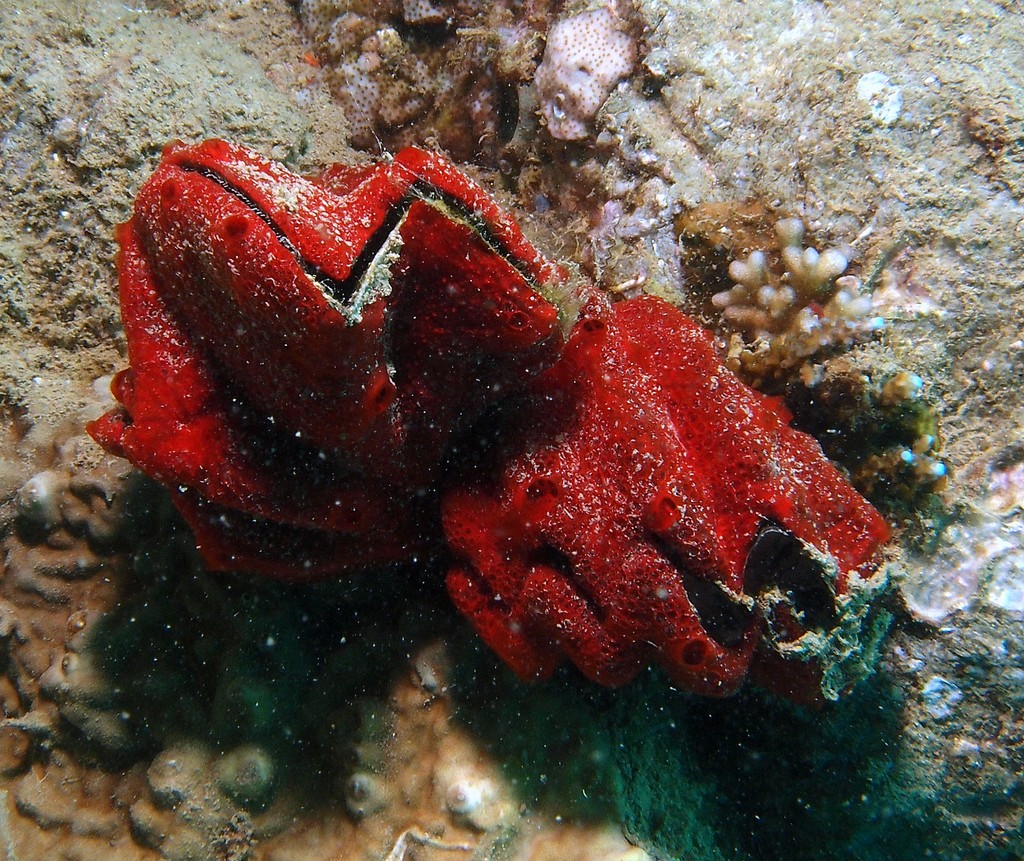LOPHA CRISTAGALLI - (LINNAEUS, 1758)
Mollusca (Phylum) > Bivalvia (Class) > Pteriomorphia (Subclass) > Ostreoida (Order) > Ostreoidea (Superfamily) > Ostreidae (Family) > Lophinae (Subfamily) > Lopha (Genus)
Huître zig-zag, Huître crete-de-coq, Cock's comb oyster, cockscomb oyster, zig-zag clam,,
Description
Ce bivalve est une huître qui se caractérise par deux valves fortement dentées en zig-zag qui s'emboitent parfaitement. L'ensemble ressemble à une crête de coq surtout quand il est colonisé par une éponge encroûtante rouge. Souvent cette ouverture est seulement la partie visible de ce mollusque. Taille adulte 10cm - 20cm. Profondeur 5 - 30m.
Biologie
Ces mollusques filtreurs se nourrissent de plancton. Lopha cristagalli se fixe sous les surplombs naturels, les épaves et souvent sur les gorgones. Elle est elle-même colonisée par de nombreux organismes épibiontes comme des éponges, des hydraires ou des bryozoaires.
Distribution
Indo-Pacifique de l'Afrique Est à la Polynésie. Présent en Nouvelle-Calédonie.
Synonymes
Alectryonia rara (Fischer von Waldheim, 1807)
Mytilus cristagalli Linnaeus, 1758)
Ostrea cristagalli (Linnaeus, 1758)
Ostrea townsendi (Melvill, 1898)
--------------------
Lopha cristagalli is a species of marine bivalve molluscs in the family Ostreidae.
Description
The cockscomb oyster has a shell reaching a maximum diameter of about 20.5 cm, commonly 10 cm. It has a variable coloration, dark to light purple, and it is a thick, strongly ribbed, and slightly inequivalve shell. The shell inside is porcelaneous, usually purplish-brown or whitish in colour. The margins of the valves have a characteristic zig-zag pattern. The surfaces of both valves have many small, low, and rounded protuberances. These molluscs are stationary epifaunal suspension feeders, as they feed filtering sea water to extract the nutrients.
Distribution
This species is widespread in the Indo-West Pacific, from East Africa, including Madagascar, Mauritius, the Red Sea, Seychelles, and the Persian Gulf, to Micronesia; north to Japan and south to Papua New Guinea and Indonesia. Reported from New Caledonia.
Biotop
It lives on coral reefs in shallow subtidal waters at depths of 5 to 30 m.
Huître zig-zag, Huître crete-de-coq, Cock's comb oyster, cockscomb oyster, zig-zag clam,,
Description
Ce bivalve est une huître qui se caractérise par deux valves fortement dentées en zig-zag qui s'emboitent parfaitement. L'ensemble ressemble à une crête de coq surtout quand il est colonisé par une éponge encroûtante rouge. Souvent cette ouverture est seulement la partie visible de ce mollusque. Taille adulte 10cm - 20cm. Profondeur 5 - 30m.
Biologie
Ces mollusques filtreurs se nourrissent de plancton. Lopha cristagalli se fixe sous les surplombs naturels, les épaves et souvent sur les gorgones. Elle est elle-même colonisée par de nombreux organismes épibiontes comme des éponges, des hydraires ou des bryozoaires.
Distribution
Indo-Pacifique de l'Afrique Est à la Polynésie. Présent en Nouvelle-Calédonie.
Synonymes
Alectryonia rara (Fischer von Waldheim, 1807)
Mytilus cristagalli Linnaeus, 1758)
Ostrea cristagalli (Linnaeus, 1758)
Ostrea townsendi (Melvill, 1898)
--------------------
Lopha cristagalli is a species of marine bivalve molluscs in the family Ostreidae.
Description
The cockscomb oyster has a shell reaching a maximum diameter of about 20.5 cm, commonly 10 cm. It has a variable coloration, dark to light purple, and it is a thick, strongly ribbed, and slightly inequivalve shell. The shell inside is porcelaneous, usually purplish-brown or whitish in colour. The margins of the valves have a characteristic zig-zag pattern. The surfaces of both valves have many small, low, and rounded protuberances. These molluscs are stationary epifaunal suspension feeders, as they feed filtering sea water to extract the nutrients.
Distribution
This species is widespread in the Indo-West Pacific, from East Africa, including Madagascar, Mauritius, the Red Sea, Seychelles, and the Persian Gulf, to Micronesia; north to Japan and south to Papua New Guinea and Indonesia. Reported from New Caledonia.
Biotop
It lives on coral reefs in shallow subtidal waters at depths of 5 to 30 m.
